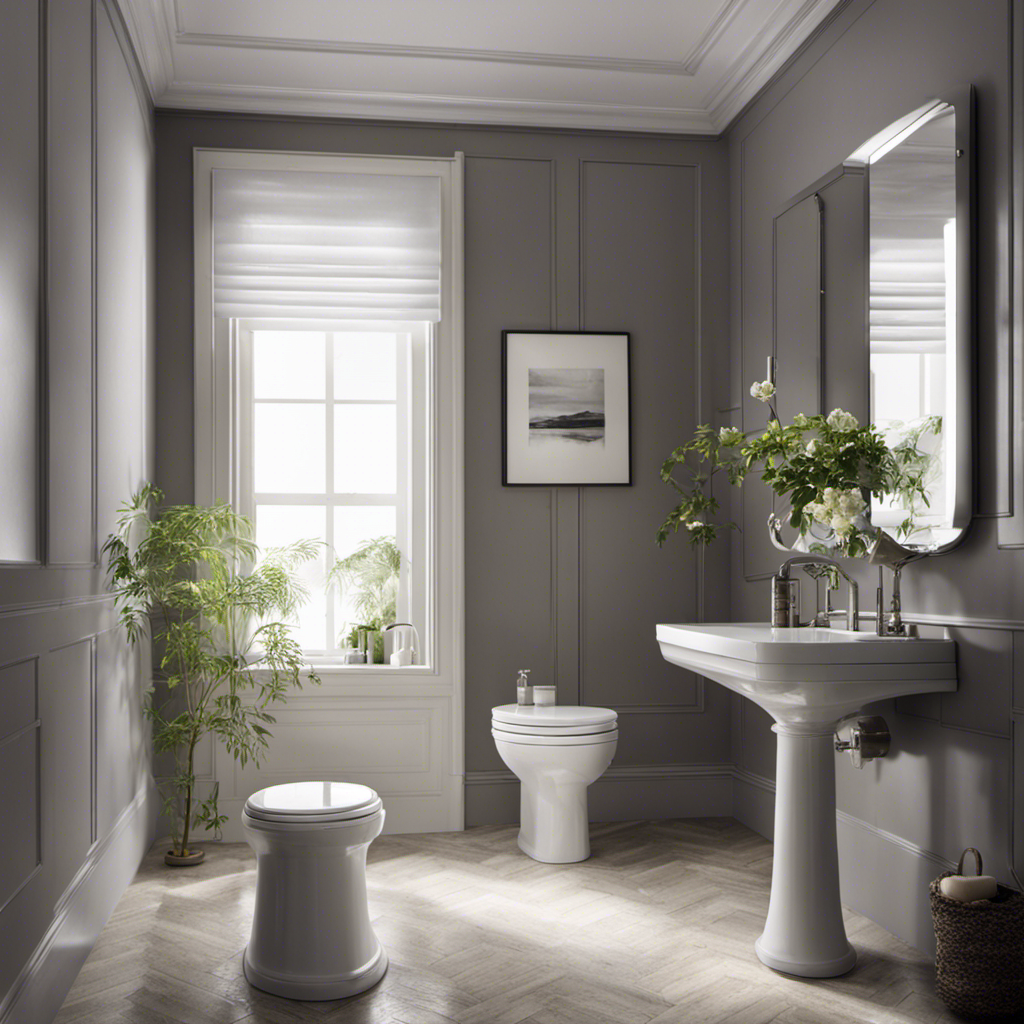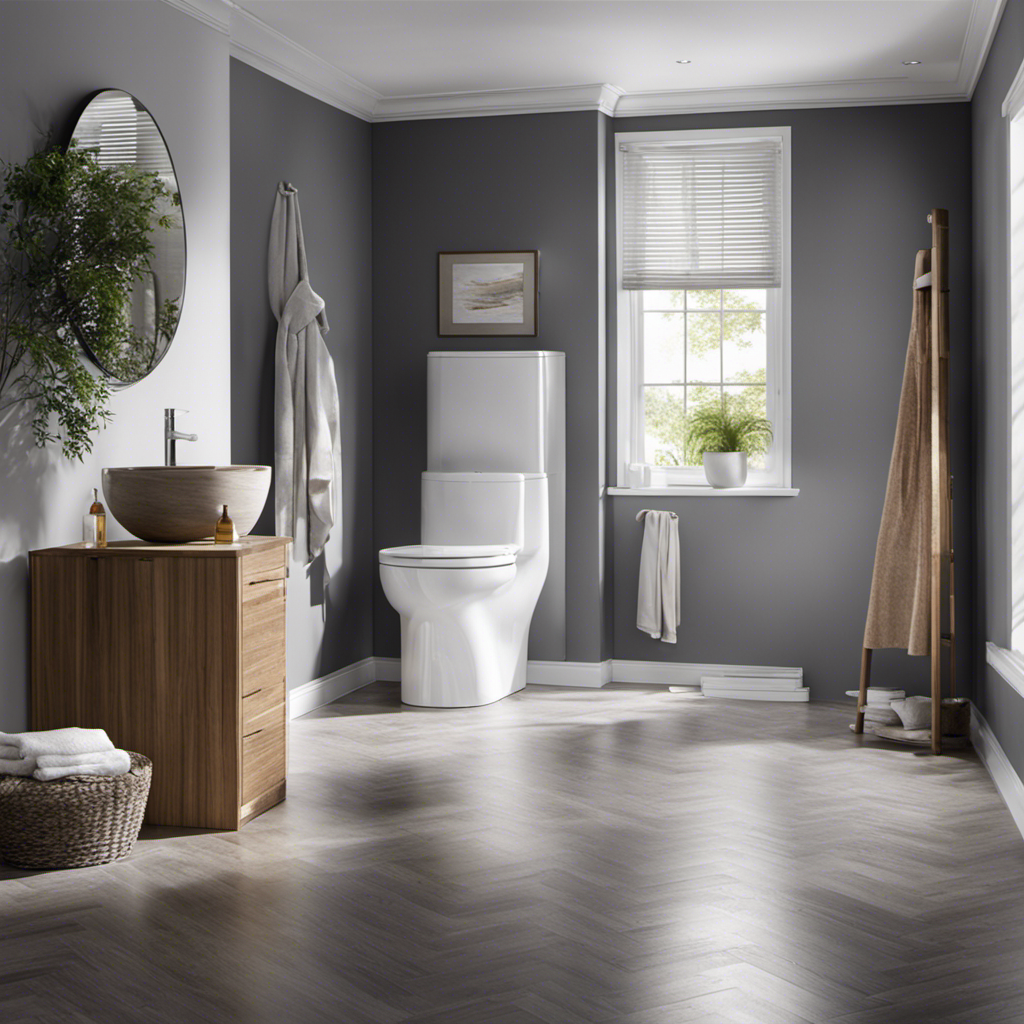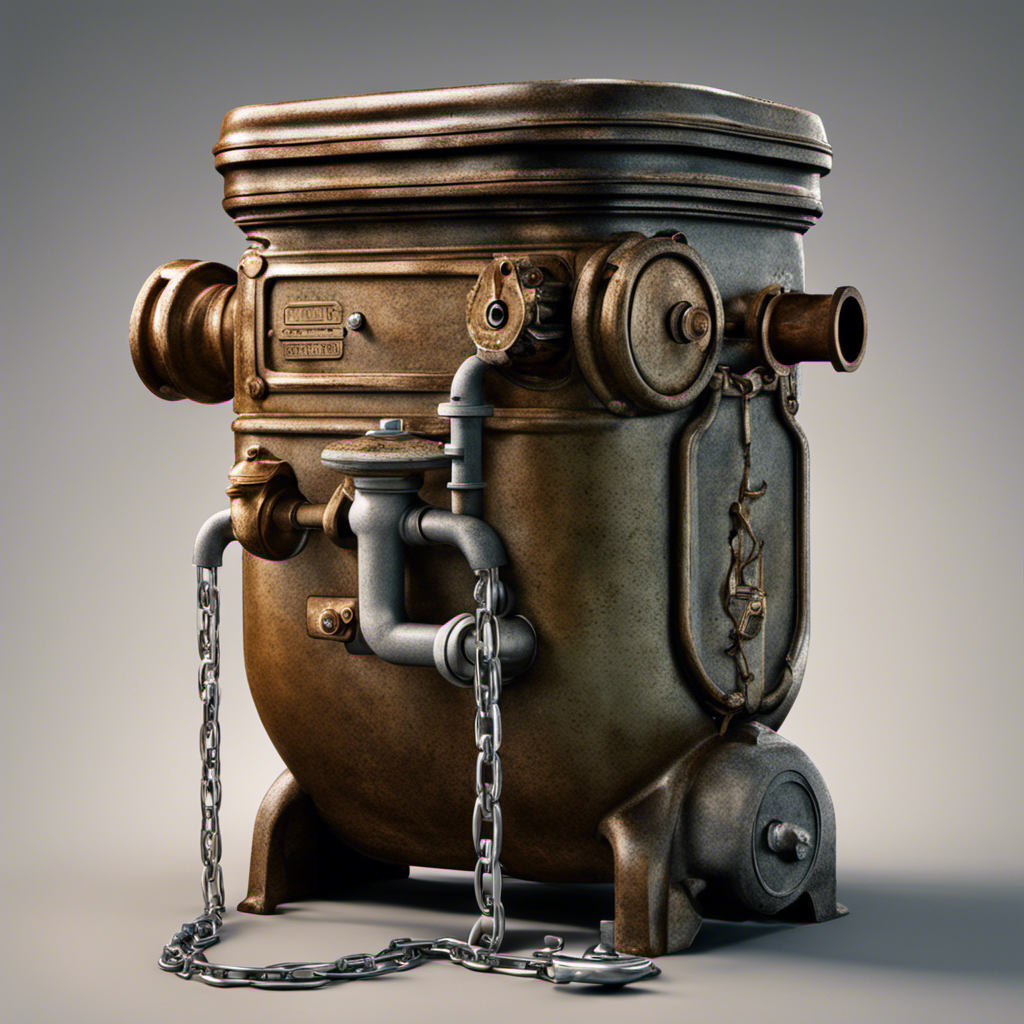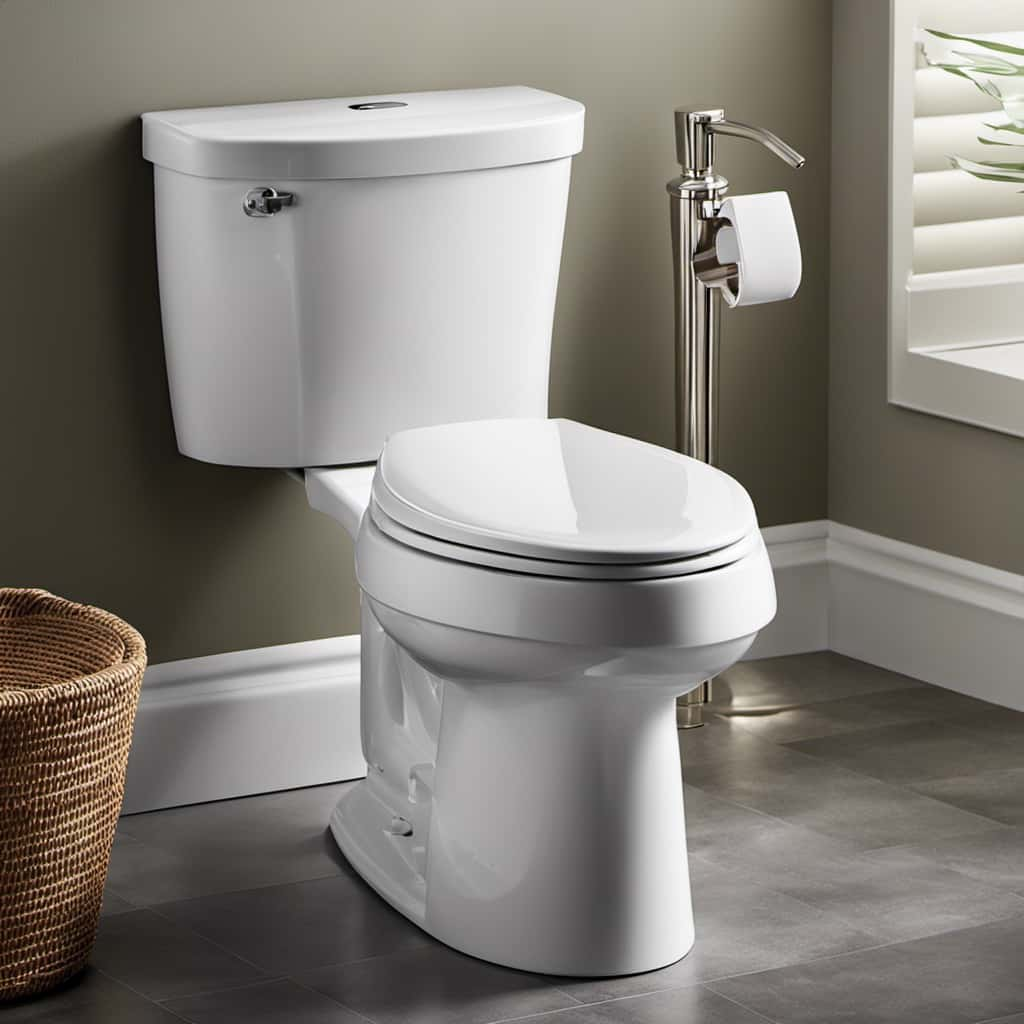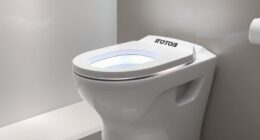As I sit in my bathroom, enjoying a moment of peace, I am suddenly startled by a strange noise coming from the toilet. It’s as if the toilet has a mind of its own, making noise when it’s not even in use.
If you’ve experienced this unsettling phenomenon, fear not! In this article, I will guide you through the common causes of noisy toilets, help you identify the source of the noise, and provide potential solutions to quiet down your unruly commode.
So, let’s dive in and put an end to the mysterious toilet symphony!
Key Takeaways
- Sudden changes in water pressure or complete loss of water flow can cause toilet noises.
- Gurgling or bubbling sounds coming from the toilet bowl are another common indicator of toilet noise.
- Regular maintenance of the fill valve and flapper can help prevent toilet noise.
- If the issue persists or is beyond your expertise, it is advisable to seek professional help from a plumber.
Common Causes of Noisy Toilets
If your toilet is making noise when you’re not using it, there are a few common causes that could be behind the problem.
Troubleshooting toilet noise can be a bit tricky, but with a little knowledge, you can easily identify and fix the issue.
One possible cause of the noise is a faulty fill valve. This valve regulates the water level in the tank and can become worn out or damaged over time.
Another common culprit is a loose or worn-out flapper. The flapper is responsible for sealing the tank and preventing water from continuously flowing into the bowl.
Additionally, a faulty flush valve can also cause noise as it fails to properly seal, allowing water to leak out.
How to Identify the Source of the Toilet Noise
You can easily identify the source of that annoying sound coming from your bathroom by checking the water supply, flapper valve, and fill valve.
When it comes to troubleshooting noisy toilets, it’s important to know where the noise is coming from in order to fix the issue effectively. Here are three areas to focus on when identifying toilet noise:
-
Water Supply:
-
Check for any leaks or loose connections in the water supply line.
-
Ensure the water supply valve is fully open and functioning properly.
-
Look for any obstructions or blockages in the water supply line.
-
Flapper Valve:
-
Inspect the flapper valve for any signs of wear or damage.
-
Make sure the flapper valve is properly sealing the flush valve opening.
-
Adjust or replace the flapper valve if necessary.
-
Fill Valve:
-
Check the fill valve for any leaks or malfunctions.
-
Ensure the fill valve is properly adjusted to the correct water level.
-
Clean or replace the fill valve if needed.
Potential Solutions for a Noisy Toilet
When it comes to dealing with a noisy toilet, two common culprits that can cause the problem are a faulty fill valve and a loose flapper valve.
A faulty fill valve, also known as a ballcock valve, can create a loud hissing or whistling sound as it struggles to regulate the water flow.
On the other hand, a loose flapper valve can produce a constant dripping or running noise due to water leakage.
Understanding these key points will help in identifying and addressing the source of the noise in a toilet.
Faulty Fill Valve
The toilet’s making noise because there’s a faulty fill valve. This is a common issue that can cause various sounds, including hissing, whistling, or even a loud banging noise known as water hammer.
The fill valve is responsible for refilling the tank after each flush, and when it malfunctions, it can lead to these annoying noises. To address this problem, you can consider a fill valve replacement. Here are some important things to know:
- A faulty fill valve can cause water hammer, which occurs when the water flow is abruptly stopped, causing a shockwave in the pipes.
- When replacing the fill valve, make sure to turn off the water supply and flush the toilet to empty the tank.
- Follow the manufacturer’s instructions for the installation process and adjust the water level to the recommended height.
Loose Flapper Valve?
If the toilet’s making noise, it could be due to a loose flapper valve. The flapper valve is a rubber seal that allows water to flow from the tank to the bowl when you flush the toilet. Over time, the flapper valve can become worn or misaligned, causing it to not seal properly. This can result in water leaking from the tank into the bowl, causing the toilet to continuously run and make noise. To fix this issue, you will need to replace the flapper valve. Here is a table outlining the steps for flapper replacement:
| Step | Procedure |
|---|---|
| 1 | Turn off the water supply to the toilet. |
| 2 | Drain the tank by flushing the toilet and holding down the handle. |
| 3 | Remove the old flapper valve by disconnecting it from the flush chain and unhooking it from the overflow tube. |
| 4 | Install the new flapper valve by attaching it to the flush chain and hooking it onto the overflow tube. |
| 5 | Turn the water supply back on and test the toilet to ensure it no longer makes noise. |
Troubleshooting Tips for Quieting a Noisy Toilet
When it comes to troubleshooting a noisy toilet, it’s important to consider whether the issue is a plumbing or mechanical problem.
Identifying the root cause will help determine the best course of action to fix the water pressure problem.
Plumbing or Mechanical Issue
You might have a plumbing or mechanical issue if your toilet is making noise when you’re not using it. This could be a sign of a problem that requires attention. Here are some possible causes and solutions to consider:
-
Faulty fill valve: The fill valve is responsible for refilling the tank after each flush. If it’s not functioning properly, it may cause noise. Regular plumbing maintenance, such as cleaning or replacing the valve, can help resolve the issue.
-
Loose or worn-out parts: Over time, various components of the toilet can become loose or worn out, resulting in noise. Tightening or replacing these parts can often eliminate the problem.
-
Water hammer: This occurs when water flow is suddenly stopped, causing a loud banging noise. Installing water hammer arrestors or adjusting water pressure can reduce this noise.
By addressing these plumbing or mechanical issues and implementing noise reduction techniques, you can enjoy a quieter toilet experience.
Speaking of water pressure, let’s now move on to fixing water pressure problems.
Fixing Water Pressure Problem
Adjusting the water pressure can help fix the water pressure problem and improve your overall plumbing system.
When the water pressure in your home is low, it can cause issues like weak flow from faucets and showers.
To increase water pressure, start by checking the water supply. Ensure that the main water valve is fully open and not partially closed.
Next, inspect the water pressure regulator, which is responsible for controlling the water pressure entering your home. If it is faulty, it may need to be replaced.
Additionally, check for any clogged pipes or fixtures that could be restricting the flow of water.
Professional Help: When to Call a Plumber
If your toilet is constantly making noise even when it’s not in use, it might be time to consider calling a plumber for professional help. While some plumbing issues can be fixed with a little DIY knowledge and a few basic tools, there are times when it’s best to leave it to the experts.
Here are some signs that indicate you should reach out to a professional plumber:
- Persistent and loud noises coming from the toilet, indicating a potential problem with the fill valve or flapper.
- Water leaks or puddles around the base of the toilet, which could be a sign of a faulty wax seal or cracked toilet bowl.
- Sudden changes in water pressure or complete loss of water flow, indicating a potential issue with the main water supply or a blocked pipe.
Preventive Measures to Avoid Toilet Noises in the Future
One way to prevent future toilet noises is by regularly maintaining the fill valve and flapper. The fill valve is responsible for controlling the water level in the toilet tank, while the flapper is a rubber seal that opens and closes to allow water to flow into the toilet bowl.
Over time, these components can become worn or damaged, leading to leaks and noisy operation. To prevent this, it is important to regularly inspect and clean the fill valve and flapper. This can be done by turning off the water supply, flushing the toilet to drain the tank, and removing any debris or mineral deposits from the valve and flapper.
Additionally, replacing these components every few years can help ensure proper functioning and prevent future toilet noise issues. By following these preventive measures, you can troubleshoot and prevent toilet noise problems effectively.
Conclusion
In conclusion, it’s crucial to address the issue of a noisy toilet promptly to avoid further inconvenience.
By identifying the source of the noise and utilizing the potential solutions mentioned, one can effectively resolve the problem.
However, if troubleshooting proves unsuccessful, it’s wise to seek professional help from a plumber.
Remember, taking preventive measures such as regular maintenance and proper usage of the toilet can prevent future occurrences of these bothersome noises.
Together, we can bid farewell to those pesky toilet noises and enjoy a peaceful bathroom experience.
